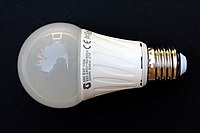
Photo from wikipedia
Abstract LED lightings have made significant contributions to global energy saving, where one major challenge is the overheating of LED chips since the light output and lifespan of LED chips… Click to show full abstract
Abstract LED lightings have made significant contributions to global energy saving, where one major challenge is the overheating of LED chips since the light output and lifespan of LED chips decrease exponentially with increasing operating temperature. Restricted by cooling capacity, the power input and light output of a LED bulb is limited. At present the luminous flux of commercial LED bulbs (A19 size) is usually limited to 800 lumen with the related power consumption within 9 W. Therefore, there is an urgent market need for high-lumen bulbs while maintaining the size and shape as conventional incandescent bulbs. We report herein a novel design which could make full use of the entire outer surface of LED bulb as heat dissipating surface under passive cooling conditions. The novel design contains a chimney inside the bulb and an external heat sink, enabling two parallel heat dissipating paths, i.e., chips - heat sink - environment and chips – chimney – lampshade - environment. In conventional design with an external heat sink for cooling, the lampshade functions only to transmit light rather than dissipate heat. However, in the novel design the chimney inside the bulb could thermally activate the lampshade to dissipate heat as well. Upon properly distributing thermal loads to the two heat dissipating paths, cooling capacity of the novel bulb was optimized. With this design strategy, the passive cooling capacity was significantly improved to be 1.57 times higher than the conventional design and the commercially available bulbs of the same size and shape. Most importantly, the design strategy may be extended to other passive cooling scenarios such as indoor small cells for 5G communication.
Journal Title: Applied Thermal Engineering
Year Published: 2021
Link to full text (if available)
Share on Social Media: Sign Up to like & get
recommendations!